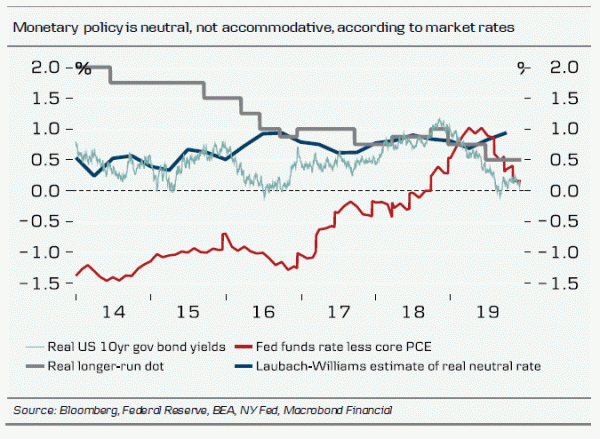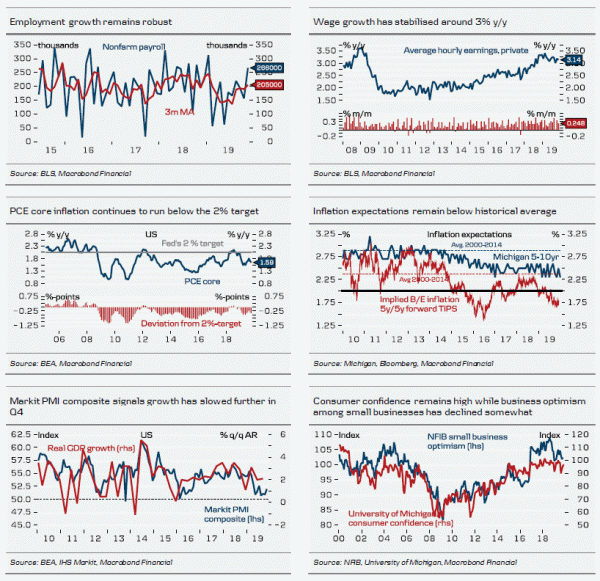Fed outlook: ‘current monetary policy stance is appropriate’ Following three cuts in a row, we expect the Fed to remain on hold (target range 1.50-1.75%) when it meets next week. FOMC members have made it clear that they think the ‘current stance of monetary policy is appropriate’ and that they now want to wait some time and see how things play out before acting again. At the latest meeting in October, the Fed surprised us by removing its easing bias and, as data has not really painted a different picture, it is difficult to see why FOMC members should change their minds (if anything the strong jobs reports in recent months should calm fears within the board despite some subdued ISM/PMI indices). Hence, we do not expect major changes to the statement.
Focus is likely to be on the updated ‘dots’ (i.e. policy rate projection). The Fed cutting once more than the median projected at the last dot update in September will automatically lower the ‘dots’ this y ear. The big uncertainty is what the Fed will signal for next year. We expect most members to signal that they expect the Fed funds target rate to remain unchanged in 2020 but we are looking to see whether one to two FOMC members signal an easing bias (however, this is not our base case).
Our base case is that the Fed may deliver a fourth cut some time in the spring. However, this is not a high conviction call. This probably diverges from consensus among Fed watchers and aligns more with market pricing (a full cut is priced in next year). We do not believe the US is heading for a recession but we think the economy is a bit more fragile than the Fed does. While the US-China trade negotiations seem to be heading in the right direction, in our view a phase 1 deal would not be enough to kick-start an investment boom. This is because the fundamental uncertainty in the short run remains high, with negotiations probably moving to phase 2 (the permanent part) (see also the US section of The Big Picture – Rays of light for the world economy, 2 December. Many investment indicators are not looking too strong at this time.
If, against our expectation, the US and China do not reach an agreement on phase 1 and Donald Trump moves forward, implementing higher tariffs on consumer goods imported from China, it is a different situation, when markets may start pricing in a higher probability of a cut in the short run too.
In addition, we disagree with the Fed when it says that monetary policy is now accommodative. The Fed cuts have led monetary policy to be around neutral (from tight previously) and, given inflation is running persistently below 2%, we believe it would be a good idea to support the economy more.
FX: EUR/USD heading lower as Fed is done
The Fed funds market is pricing the Fed keeping rates on hold in December and with a high probability in January too (based on the effective Fed funds at 1.55%). Hence, next week’s Fed meeting might not end up being a significant market mover on the day. That said, the market is still pricing some probability of another 25bp rate cut in H1 next year. If the Fed affirms its wait-and-see stance, we could see USD rates go a bit higher, which should send EUR/USD lower. We forecast EUR/USD will go to 1.09 in 1M.
Regarding the US money market, there are a couple of other issues on the Fed’s laundry list. We expect the market to keep an eye out for any hints on the Fed’s liquidity provision. It is set to provide an updated schedule for repo operations on Thursday but may air some hints at the meeting. Furthermore, the effective funds rate has fixed around 1.55% for some weeks now and now is at the low end of the Fed’s target rate. The market hopes to get a sense of the Fed’s urgency to get it back to the middle of the range, which it could achieve through, for example, a 5bp hike of the interest on excess reserves (IOER) in January or M arch 2020.
Fixed income: little impact expected
The FOMC should have little impact on the US treasuries market, as we do not expect a material impact on market pricing. Long-dated Treasuries are currently trading mainly on risk appetite and less on the monetary policy outlook. That said, we believe the market will follow the ‘dots’ closely to see whether the current market pricing pointing to an accumulated 25bp rate cut in autumn 2020 makes sense.
















